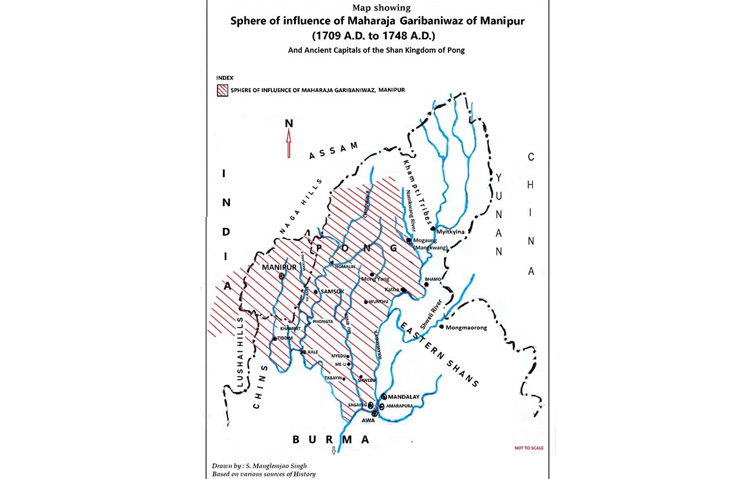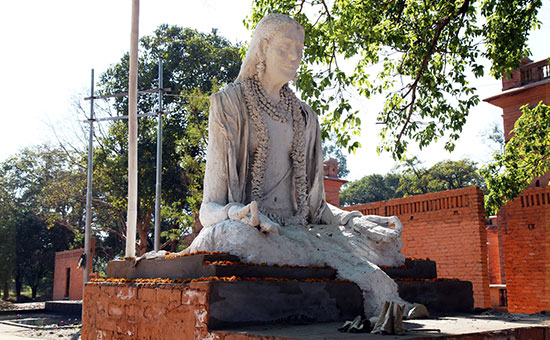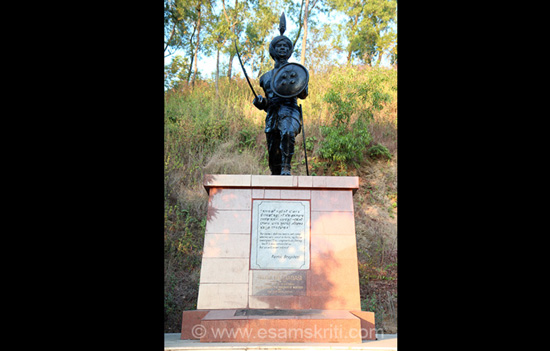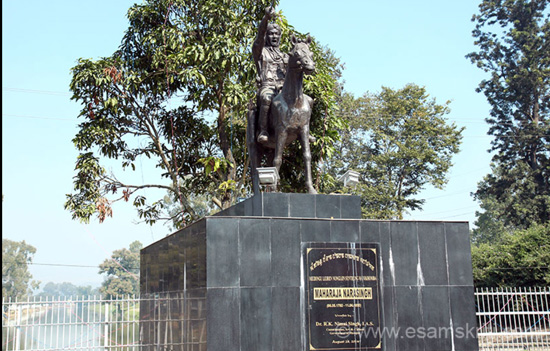- Know about
the greatest king of Manipur Pamhieba 1709-1748, his victories over kings of
Burma and Hill tribes. Why were the Manipuris successful at war? Why and how did
Vaishnavism enter Manipur?
Northeastern
India is one of the most ignored parts for students of Indian history.
From ancient
times to the modern era, the north eastern states had long well recorded dynasties
and a glorious history. These dynasties
had rulers who changed the course of history and left an impact on the region.
One such king was Pamhieba who carried successful campaigns in India and captured parts of Burma too. (till about 1936 Burma was an administrative part of British India). “No other ruler in eastern India could boast of such a glorious military conquest in north eastern India and Burma in the early 18th century.” 1 Pg. 239
Manipur,
ancient name Kangleipak, is known for its music, culture and dance esp. the
Raas Leela. It has a large number of lakes and forests. Manipur was one of the
routes between the Indian subcontinent and Southeast Asia.
Quick Summary
“The evolution of Manipur from a tribal or lineage based policy to a full fledged feudal in the 15th century during the reign of Kyamba was a
significant historical achievement. Manipur reached the climax of her glory during
the reign of Pamhieba in the 18th century when he conquered upper
Burma. The conflicts with Burma and internal differences greatly weakened the
kingdom of Manipur in the early 19th century leading to the Burmese conquest of Manipur, known as Seven years of Devastation (1819-1826). The Burmese threat led to Manipur to look towards western neighbors, the British, for its liberation.” 1
Background
The Ningthouja
dynasty ruled Manipur from the 3rd to the 20th centuries, is one of
the oldest dynasties of India. Ningthouja dynasty claims its origin from
Pakhangba, who started his rule from 1st (1) or 3rd century.
After him
his seven sons ruled Manipur at different times. They were followers of Sanmahi, the ethnic religion of Meitei
people.
Since the 15th
century, Vishnu worship was patronized by the Kings of Manipur. In the 15th
century, there is a mention of a Hanuman murti presented by neighbourhood
kingdom to the Manipuri king, who then built a temple.
During the
reign of Pitambar Charai Rongpa, Vaishnav Dharma started becoming main stream
in Manipur. The king was formally initiated into Vaishnav Dharma in April 1704,
by a Brahmin named Krishnacharya who came from Puri, Odisha. 1 Pg. 237 The king constructed several
temples for Meiti deities and others. He built a Krishna Temple that can be
found at Brahmapur locality of Imphal.
The
beginning of the 18th century was the dawn of a new era in the
history of Manipur. In this change Charai Rongba (1697-1709), Garibaniwaza (Pamhieba
1709-1748) and Bhagyachandra played significant roles. 1 Pg. 233
 Sphere of Influence of King Pamheiba.
Sphere of Influence of King Pamheiba.
Garibaniwaza (Pamhieba) 1709 to 1748
His Hindu
name was Gopal Singh (a protector of friend of the cow). He was also called
Manipureswar. Muslim immigrants gave him the name Garibaniwaza. 1 Pg.
240
Pamhieba,
also known as Meetingu Mayampha, was born in 1689 to Pitambar Charai Rogpha who
had given his daughter to Burmese emperor. But the emperor of Burma misbehaved
with her (some say the marriage ran sour 1).
When
Pitambar heard about this, he called his ministers and planned invasion on
Burma. But before he could invade, he fell ill and on deathbed, he took promise
from his son Pamhieba that he will invade Burma and avenge the disrespect of
his sister.
Pamhieba ascended the throne on 28th August 1709. J. Roy described “Pamhieba as the ‘mighty Vaishnava ruler and conqueror with the martial quality of a Kshatriya and the humility of a Vaishnava who styled himself as the refuge of the poor.” 1 Pg. 240 His military conquests were
on three fronts, one the hill tribes for internal consolidation, two wars
against Burma and three wars against Tripura.
His first challenge
was to curb the revolts by various tribes. Pamhieba conducted almost 27
military expeditions into hills of Manipur. These raids had three purposes -
To extract
tribute, To curb the rebellion and To exert the authority of Manipur.
He was
successful in all those military expeditions. After subduing all those rebel
chiefs, he rearranged the administrative system for effective management. In
1733, he sent a military expedition to Ukhrul which was conquered by the Meiti
forces.
Later on he
followed a policy of friendship with tribal chiefs during his wars with Tripura
and Burma. Many tribal warriors fought for the Manipur army.
One strong
base of his reign was his control over the hill tribes and political support
from them. He introduced some changes in the administration of the hill areas
which upset the hill tribes. In the previous reigns, the chronicles refer to
the headman of the tribal villages as chiefs (ningthou). But from his time the word ‘Khullakpa’ (administrator of the village was used) to mean village chiefs. 1 Pg. 242
His repeated
invasions of Burma demonstrated his military might and gave a death blow to the
already declining Toongoo dynasty. The wars were fought over 1717-1748.
King of AVA (below Mandalay,
see map above)
In 1717, the
emperor of Ava, Taninganwe sent a team of Burmese officials to ask for the hand
of a Manipuri princess of him. According to Burmese tradition, if the hand was
given it would increase the stock of the king in the eyes of the people. King
Pamheiba agreed to the proposal and said the princess would be given in the
next year. She should be received at the Chindwin river, the boundary of
Manipur and Ava. Instead of a princess, a Manipuri force went and killed the
Burmese party. This way he took revenge for the treatment meted out to his sister.
To avenge
this, Burmese Emperor sent a huge army to towards Manipur. On 16th January
1718, a fierce battle was fought between both the armies at the battle of
Wangjing in which Manipur won. Many Burmese soldiers were taken as slaves. In
this battle, Pamhieba personally led his army from front.
The Burmese
invasion was possible because of the weak control of Manipur over Kabaw valley.
He cleared the area of Burmese penetrators. During 1718-23, the king was
engaged in reasserting the political power of Manipur and consolidating the
same in Kabaw valley. 1 Pg. 245
Campaigns
in Kabaw Valley
Pamhieba
conducted many raids in Kabaw valley where he defeated the Burmese and some
local Shans. With the conquest of Kabaw valley Manipur became an important
power with the Shan states in upper Burma.
Burmese
Invasion of 1723
In 1723,
Burma and Tripura both invaded Manipur simultaneously. The former crossed Kabwa
valley and Tengnoupal hills. The latter invaded in the south western part of
the valley.
After an
initial setback Pamhieba personally entered the battle and guided his team to
victory. The army consisted of 4,000 tribal soldiers, 5,000 Meiti soldiers and
300 well trained cavalry armed with deadly arambai (read about it below).
In 1725 he
defeated the invading Burmese army. In 1735-36 he invaded Burma and defeated
them. In 1735, Pamhieba invaded Burma and captured Myedu (currently in Sagaing
region of Myanmar). In 1737 he defeated an invading Burmese army.
Sack
of Sagaing, 1738
Sagaing, was
the then capital of the Burmese empire.
In 1738 he
crossed the Chindwin river with a force of 20,000 men and cavalry and invaded
the kingdom of Ava. The Burmese were defeated.
In 1740 he
received a marriage proposal from Burmese king for his daughter. On finding the
king sincere he agreed to give his daughter in marriage to the Burmese king.
War
against Tripura
When the
Tripuris and Burmese invaded Manipur as stated above, the king first defeated
the Burmese and then personally led the battle to defeat the Tripuris.
Thus,
Manipur, who was afraid of invasions from Burma, under Pamhieba, invaded Burma
many times and conquered its capital city. Under his reign, Manipur expanded
vastly.
If there is bad blood today between
the Burmese and Manipuris today, there are historical reasons for it.
 Rajarshi Bhagyachandra. Kangla Fort 2014.
Rajarshi Bhagyachandra. Kangla Fort 2014.
Rajarshi Bhagyachandra
Pamhieba was
followed by Raja Bhagyachandra. Rami Desai wrote, “Rajarshi Bhagyachandra or Ching-Thang Khomba was born in 1740 and ruled Manipur for forty years from 1759-1761 and 1763-1798. Rajarshi Bhagyachandra (the lucky one) was called so because he is said to have received the blessings of Shri Govindaji. It was during Rajarshi’s reign that Hinduism reached its peak in Manipur.
His contribution towards cementing the position of Hinduism in Manipur as well as creating a movement rooted in Bhakti resulting in an unsurpassed vibrant culture is still evident in Manipur. Rajarshi’s contribution through development, mentorship and institutionalising of Vaishnavism in Manipuri society may not be measurable in any way but is certainly palpable in the spirited and in the civilised society that Manipur is.
Rajarshi,
who saw the Bhakti aspects of Vaishnavism as reverence to God further went on
to establish the Nat Sankirtana, a crucial
form of worship in Manipur. In Manipur this amalgamation of Pre-Vaishnav Meitei culture with Hinduism led to a greater ideal which is the ‘Meiteisation of Hinduism.”
Why
were the Manipuris successful at war?
1. Pamhieba and his predecessors had built up a strong state system based on a sound economy coupled with sufficient natural resources in Manipur and Kabaw valleys.
2. The hill tribes gave strong support to the king.
3. A well organized military organization. Manipur did not have a standing army but Manipur was a nation at arms. The militia was well organized through the Lallup. (“The general system of lallup is based on the assumption that it is the duty of every male between the ages of 17 and 60 to place his services at the disposal of the state, without remuneration, for a certain number of days in each year.” Source)
4. Manipuri people were good at using at the sword, spear and brave.
5. It was the cavalry equipped with deadly arambai which proved to be very effective for the forces.
“Arambai, literally meaning darts, is a simple weapon at first sight. The weapon has an iron arrow head, which is attached to feathers of peacocks though kites' feathers were also used in the past. Users of these weapons, who are horse riders, swirl the deadly poisoned darts and throw it to the enemy with an unparalleled accuracy and speed which is gathered through fast galloping of the Manipuri ponies.” Source Note that POLO was founded in Manipur in the
1850s.
Apart from
military campaigns, Pamheiba was a man of art, culture and administration. He
rearranged the administrative system, made new posts for effective management
of state and unified various parts of country under one central authority. His
reign witnessed strict punishments and swift justice. Penalties like mutilation
and death being usually inflicted on culprits. He divided his subjects in four
panas and regularly went out to inspect places and see his people. His reign
witnessed growth and development of administrative machinery of Manipur. He did
a lot of good work for the poor.
The region
was named Manipur (land of gems), earlier Kangleipak, in the early 18th
century. 1
Why
and how did Vaishnavism enter Manipur?
Since Brahmins
faced prosecution by Aurangzeb they moved to northeast India namely Assam,
Manipur and Tripura.
The first
Meiti king who have became a Vaishnav was king Charairongba in 1704 A.D.
Vaishnavism received an impetus under Pamhieba. In the beginning of the 18th
century Meitis followed ancient Meitie religion, hill tribes practiced
animistic religion and Shans of Kabaw valley were Buddhists.
After 1720, Pamhieba
became Ramanandi a Vaishnava. He minted coins had portraits of Sri Rama on it.
He was great patron of art and Hindu literature. During his reign Ramayana,
Mahabharata were translated to local languages. He himself was a scholar who
wrote a book named Lakshmi Charit in the form of dialogue between Lakshmi and
Krishna. During his reign, he built temples all over the kingdom. The king made
a number of temples dedicated to Sri Krishna and Kailka. 1 Pg. 252
After a long
and eventful reign of 39 years, Pamhiepha died in 1748 at the age of 59 years. His
reign marked the zenith of Manipur in all respects namely religious reform,
military conquest, a sound economy, cultural and literary achievement.
Hope this
short article gives you some insights into the history of Manipur and cause of
animosity between the Burmese and Meitis.
See Indigenous
Games of Manipur to know how fit the Manipuris are
References
1. History of Manipur by Gangmumei Kabui Volume 1 – borrowed a lot of matter from this book for which extremely grateful. All credit to authors of 4 reference books.
2. Chronology of Meitei Monarches.
3. History of Manipur by Jyotirmoy Roy.
4. A short history of Manipur By R K
Jhalajit Singh.
To read all
articles by author
To see all albums on Manipur
Read Rajarshi
Bhagyachandra and Bhakti in Manipur and Imphal
Reviews article on king Pamheiba
 Maj General Paona Brajbasi. Died in 1891 fighting the British. Also see image of General Thangal, hero of the Anglo-Manipuri war of 1891.
Maj General Paona Brajbasi. Died in 1891 fighting the British. Also see image of General Thangal, hero of the Anglo-Manipuri war of 1891.
 Maharaja Nar Singh 1792-1850. He built the Shri Govindji temple in Imphal. He was an expert in Manipuri martial art of Satjal.
Maharaja Nar Singh 1792-1850. He built the Shri Govindji temple in Imphal. He was an expert in Manipuri martial art of Satjal.